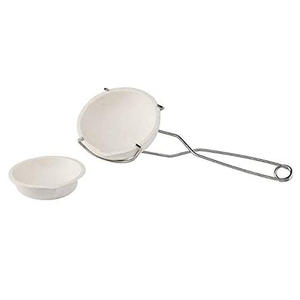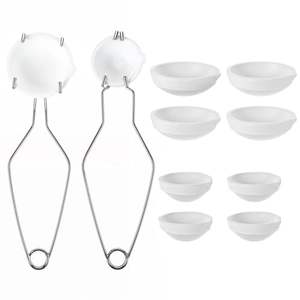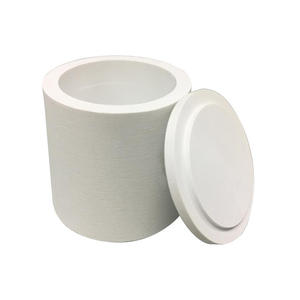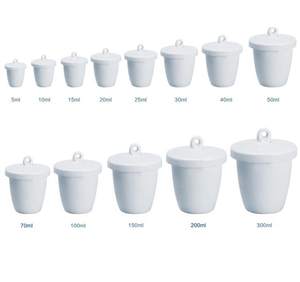Professional industry ceramic supplier, silicon nitride, silicon carbide, aluminum nitride and any other kinds of ceramics.
PRODUCT PARAMETERS
Description
Overview of Ceramic Crucible for HORIBA Carbon Sulfur Analyzer
Ceramic Crucible for HORIBA Carbon Sulfur Analyzer are specialized containers designed for withstanding extremely high temperatures in laboratory and industrial settings. They are essential for processes such as melting, calcining, and heat-treating a wide variety of materials, including metals, glasses, and chemicals. Our crucibles are engineered for superior thermal stability and chemical resistance, ensuring purity and reliability in the most demanding applications.
Features of Ceramic Crucible for HORIBA Carbon Sulfur Analyzer
-
Exceptional Thermal Shock Resistance: Withstands rapid temperature changes without cracking, ensuring durability and a long service life.
-
High-Temperature Stability: Maintains structural integrity at extreme temperatures, often exceeding 1500°C.
-
Excellent Chemical Inertness: Resists corrosion and reaction with molten metals, acids, and aggressive chemical fluxes.
-
High Purity & Low Contamination: Manufactured from premium materials to prevent sample contamination during sensitive processes.
-
Optimized Thermal Properties: Designed for efficient heat transfer and consistent performance in furnace environments.
-
Robust Mechanical Strength: Offers good resistance to physical impact and abrasion during handling and use.
Specifications of Ceramic Crucible for HORIBA Carbon Sulfur Analyzer
This ceramic crucible deals with HORIBA carbon sulfur analyzers. It holds the example for analysis. The crucible is made from high-purity ceramic material. This material holds up against the intense warm needed for screening. It handles temperatures needed by the analyzer. The crucible’s form is important. It fits flawlessly inside the analyzer’s combustion tube. This makes certain right placing every time. Standard dimensions are generally used. Common dimensions are offered for different models. Constantly check your analyzer design needs. Making use of the right size avoids problems. The ceramic product is chemically inert. It does not react with the sample. This protects against contamination of your outcomes. Crucible pureness matters a great deal. High-purity porcelains reduce background carbon and sulfur. Low history levels mean even more precise readings for your examples. The crucible has to withstand thermal shock. Quick heating and cooling down happen during analysis. A sturdy crucible takes care of these adjustments without cracking. Constant efficiency is important. Good crucibles give repeatable outcomes test after test. They contribute to dependable data. Crucibles are typically for solitary use. Dispose of them after one analysis. Utilizing a fresh crucible stays clear of carryover from previous samples. Carryover affects accuracy. Comply with the analyzer supplier’s standards. Proper crucible usage preserves tool efficiency.
Applications of Ceramic Crucible for HORIBA Carbon Sulfur Analyzer
Ceramic crucibles are essential parts for the HORIBA Carbon Sulfur Analyzer. They hold the example throughout the high-temperature burning procedure. The analyzer burns the example to launch carbon and sulfur gases. These gases are then measured. The crucible has to stand up to extreme heat without damaging or polluting the example. That’s why special ceramic is made use of.
This ceramic is made mostly from alumina. Alumina ceramic deals with very heats conveniently. It remains solid even when heated up rapidly in an oxygen heater. Various other materials could melt or crack. Metal crucibles can include unwanted carbon or sulfur. Ceramic crucibles are extremely pure. They do not include extra carbon or sulfur to your measurement. This purity is crucial for accurate results.
The crucible shape is important as well. The HORIBA crucibles are developed for reliable burning. Oxygen streams around the sample well. This makes certain the sample burns entirely. Full combustion suggests all the carbon and sulfur is launched. You get a real dimension of the example’s content. Making use of the wrong crucible shape can trap gases or leave unburned material.
Using these ceramic crucibles makes the analyzer job dependably. They are secure. They last through many heating cycles. You will not need to change them continuously. This conserves time and money. Clean results depend on a clean crucible. Constantly use new crucibles for important tests. Reusing crucibles threats contamination from previous examples.
Proper crucible use is uncomplicated. Position your example inside. Include accelerators if needed. Place the crucible into the analyzer’s heating system. The equipment does the rest. Count on the ceramic to stand up and keep your analysis pure.
Company Profile
Tanki New Materials Co.Ltd. focus on the research and development, production and sales of ceramic products, serving the electronics, ceramics, chemical and other industries. Since its establishment in 2015, the company has been committed to providing customers with the best products and services, and has become a leader in the industry through continuous technological innovation and strict quality management.
Our products includes but not limited to Aerogel, Aluminum Nitride, Aluminum Oxide, Boron Carbide, Boron Nitride, Ceramic Crucible, Ceramic Fiber, Quartz Product, Refractory Material, Silicon Carbide, Silicon Nitride, ect. please feel free to contact us.

Payment Methods
T/T, Western Union, Paypal, Credit Card etc.
Shipment Methods
By air, by sea, by express, as customers request.
5 FAQs of Ceramic Crucible for HORIBA Carbon Sulfur Analyzer
What is this ceramic crucible for?
This crucible holds your sample inside the HORIBA Carbon Sulfur Analyzer. It sits directly under the furnace. The analyzer heats the crucible extremely hot. This heat burns your sample material. The crucible must withstand this intense heat without breaking or adding unwanted elements to your sample.
Can I use this crucible more than once?
No. Use each ceramic crucible only one time. Using it again risks contaminating your next sample. Leftover material from the first test might still be inside the crucible. This leftover material could mix with your new sample. That mix would give you wrong results for your new test. Always use a fresh crucible for each new analysis.
How do I handle the crucible correctly?
Handle the crucible very carefully. Use clean tweezers made for lab work. Never touch the crucible with your bare fingers. Oil or dirt from your skin can stick to the crucible. This contamination affects your analysis results. Place the crucible gently into the analyzer. Avoid dropping it or bumping it hard.
Why does the crucible break sometimes?
Crucibles can break because of sudden temperature changes. The furnace heats up very fast. This quick heat change stresses the ceramic material. Small cracks might form. Sometimes the crucible cracks completely. Always check the crucible for damage before you use it. A cracked crucible is no good.
Where do I get replacement crucibles?
Buy replacement crucibles directly from HORIBA or their approved suppliers. Use only the crucible type specified for your analyzer model. Other crucibles might look similar but won’t work the same. The wrong crucible could cause problems like bad results or damage to your machine. Check your analyzer’s manual for the correct part number.
REQUEST A QUOTE
RELATED PRODUCTS

High Temperature PbN Ceramic Crucible Excellent Corrosion Resistant Pyrolytic Boron Nitride Crucible BN Pot

Non-Wetting BN Boron Nitride Ceramic Crucible

High Quality Graphite Crucible 10kg 40kg Graphite Ceramic Crucible 50kg Silicon Carbide Crucible for Aluminum Melting

A Solid Fortress to Protect Material Transformation – Aluminum Nitride Ceramic Crucible

High Heat Resistant 95% Alumina 99% Alumina Ceramic Crucible



